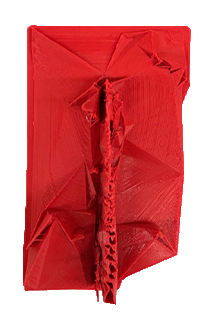Though photo is my primary artistic lens, I hybridize my process to incorporate web and graphic design, making fun combinations. My BFA thesis work was creating a virtual gallery called DCODE and 3d photos using depth maps, (as banners and 3d prints,) as the featured show about language and translation.
DCODE’s inaugural show, Translations, stemmed from my vernacular of found still life photography. After collecting and curating the photos, I produced 20 print works. The body of work is rooted in photography, translating the two-dimensional photograph to three-dimensions. From the original photos, selected for the color palette, how well they would translate into 3D, and initial compositional aesthetics, they were translated into 10 individual PLA prints at 4 by 6 inches and the in-between transliterations of more translations were printed on 24 by 36-inch banners. These individual vertical compositions changed their physical makeup to be traceable but also very different from the original, much like the translation of spoken or written language from one to another, hence the title of the show. Each 3D piece has a visceral effect and although they have an alien look, one may be reminded of a digital histogram or an assembly of varying amplitudes, a topography of shadow. The banners are a bit more familiar, in that they display images, but outside of a mass-produced, commercial environment the objects seem out of place. The feeling is furthered by the eye-tricking imagery they showcase- being between two-dimensions and three.
Breaking away from the original plan to show as a physical pop-up at The Anderson (in Richmond, VA), the Translations show was swiftly installed online as a virtual installation, not just an online complement. This display method calls on my intention to show the realness of the virtual, playing with virtual space and reforming the flattened. The gallery is cemented as real due to its connection to a domain, server, and outside social media and the elements within that are accompanied by rhetoric that is at the precipice of being believable and absorbing a viewing in the AI assisted narratives. It is further made real using print, in the ‘Spring catalog’ and other promotional material produced by the gallery- including a shop with merchandise. Overall this work treats the virtual, as valid a space as a brick and mortar gallery, and showcases the combined skill and experimentation needed to move between real and fictional, flat and formed images, and art and design languages.





























